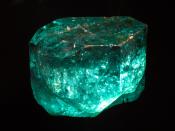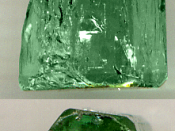The Emerald is a rich green stone that can be more valuable than a diamond of the same size. Emeralds are part of the beryl family of precious stones. They have a hardness of 8 to 10 on the Mohs scale. The green color is caused by the traces of chromium and iron in the mineral. The luster of the mineral is considered to be pearly or vitreous. Emerald is considered a gem, or a mineral that is desired for its beauty. In this paper I will discuss the value of Emeralds as well as their history, and also the classification of emeralds and the differences in these classifications. Also I will briefly touch on how the difference in these classifications affects the value of an Emerald type. There are many types of Emeralds today, but the two main classifications are Synthetic and Non-Synthetic Emeralds.
During the rule of Cleopatra in Egypt, the people were the first to have used emeralds around 2000 BC.
Cleopatra had claimed an emerald mine for herself due to her high infatuation with emeralds. Comparing an emerald and it quality to one that was found in the year 2000 BC shows that they were of very low quality. High quality emeralds today are found in Colombia (Sinkankas 4).
The Aztec and the Incas were considered to possess large high-quality emeralds during their existence. That was soon to change when the Spanish Conquistadors invaded the Inca territory and swindled the Indians for their gemstones due to its breath-taking beauty. Something that I found to be intriguing as well as interesting was the Moguls in India inscribed their religious text onto emerald tablets.
Synthetic emeralds are ones that are produced in a laboratory but duplicate natural emeralds entirely. The other type of Synthetic emerald is a...


